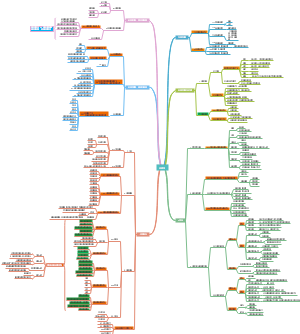导图社区 生化
- 123
- 0
- 0
- 举报
生化
这是一篇关于生化的思维导图,主要内容有1.Chemical structure2.Biosignificance of Carbohydrates3.Elemental composition等。
编辑于2022-11-12 11:35:20 山东省- 相似推荐
- 大纲
Chapter 8 Carbohydrates Metabolism
§1 Overview
1. Chemical structure
1)polyhydroxy aldehydes
2) polyhydroxy ketones
2. Biosignificance of Carbohydrates
1) major source of carbon atoms and energy
2) Supplying a huge array of metabolic intermediates
3) The structural elements in cell coat or connective tissues
3. Elemental composition
Cx(H2O)y
4.Classification
1)Classified by the number of Monosaccharide
Monosaccharide: the smallest unit of sugar that cannot be hydrolyzed
Oligosaccharide:2-10
Polysaccharide:>10
2)Classified by functional groups
Aldose
Ketose
§2 Anaerobic glycolysis [①glucose →2lactic acid (lack of O2) ②All of the enzymes of glycolysis locate in cytosol.]
1. The procedure of anaerobic glycolysis
1) Glycolytic pathway : G → pyruvate including 10 reactions
(1)G phosphorylated into G-6-P
(2)G-6-P → fructose 6-phosphate
(3)F-6-P → fructose 1,6-bisphosphate
(4)F-1,6-BP → 2 Triose phosphates
(5)Triose phosphate isomerization
(6) Glyceraldehyde 3-phosphate → glycerate 1,3-bisphosphate
(7)1,3-BPG → glycerate 3-phosphate
(8)Glycerate 3-phosphate → glycerate 2- phosphate
(9)Glycerate 2-phosphate → phosphoenol pyruvate
(10) PEP →pyruvate
2) Pyruvate → lactate
2.Regulation of Glycolysis [Three key enzymes catalyze irreversible reactions : Hexokinase, Phosphofructokinase & Pyruvate Kinase.]
1) PFK-1 (the rate-limiting step of the Glycolysis pathway)
2) Pyruvate kinase
3) Hexokinase and glucokinase
3. Significance of glycolysis
1) Glycolysis is the emergency energy- yielding pathway.
2) Glycolysis is the main way to produce ATP in some tissues.
§3 Aerobic Oxidation of Glucose
1. Process of aerobic oxidation
1) Oxidative decarboxylation of Pyruvate to Acetyl CoA
irreversible
in mitochodria.
2) Tricarboxylic acid cycle(TAC)
The net reaction of the TAC: acetylCoA+3NAD++FAD+GDP+Pi+2H2O → 2CO2+3NADH+3H++FADH2+GTP+ HSCoA
Irreversible and aerobic reaction
The enzymes are located in the mitochondrial matrix.
2. ATP produced in the aerobic oxidation
1)acetyl CoA → TAC : 3 (NADH+H+) + FADH2 + 1 GTP → 10 ATP
2)pyruvate →acetyl CoA: NADH+H+ → 2.5 ATP
3)1 G→2 pyruvate:2 (NADH+H+)+2 ATP →5 or 7 ATP
3. The regulation of aerobic oxidation
The Key Enzymes of glycolysis
Pyruvate Dehydrogenase Complex
Citrate synthase
Isocitrate dehydrogenase (rate-limiting )
a-Ketoglutarate dehydrogenase
§7 Blood Sugar and Its Regulation
1. The source and fate of blood sugar
1)source
dietary supply
liver glycogen
non-carbohydrate (gluconeogenesis)
other saccharides
2)fate
CO2 + H2O + energy
glycogen
other saccharides
non-carbohydrates (lipids and some amino acids)
2. Regulation of blood sugar level
1)insulin
decreasing blood sugar levels
2)glucagon
increasing blood sugar levels
3)glucocorticoid
increasing blood sugar levels
4)adrenaline
increasing blood sugar levels
3. Abnormal Blood Sugar Level
1)Hyperglycemia: > 7.22~7.78mmol/L
2)The renal threshold for glucose: 8.89~10.00mmol/L
3)Hypoglycemia: < 3.33~ 3.89mmol/L
§6 Gluconeogenesis
1. Gluconeogenic pathway
1) The shunt of carboxylation of Pyr
2) F-1, 6-BP →F-6-P
3) G-6-P →G
2. Regulation of gluconeogenesis
1)Substrate cycle
2)futile cycle
3. Key enzymes of gluconeogenesis
1) PEP carboxykinase
2) Pyr carboxylase
3) Fructose-bisphosphatase
4) Glucose-6-phosphatase
4. Significance of gluconeogenesis
1) Replenishment of Glucose by Gluconeogenesis and Maintaining Normal Blood Sugar Level
2) Replenishment of Liver Glycogen
3) Regulation of Acid-base Balance
§5 Glycogen synthesis and catabolism
1. Glycogen synthesis (Glycogenesis) [occurs in cytosol of liver and skeletal muscle mainly]
1)key E
Glycogen synthase
2)primer
Glycogenin
3) glycogen anabolism
1 G consumes 2~P
4)UDPG
G active pattern, G active donor
5) enzyme
Branching enzyme
2.Glycogen catabolism (glycogenolysis) [There is no the activity of glucose 6- phosphatase (G-6-Pase) in skeletal muscle.]
1)key E
Phosphorylase
2)end products
85% of G-1-P and 15% of free G
3)enzyme
Debranching enzyme
3. Regulation of glycogenesis and glycogenolysis
1) Allosteric regulation
2) Covalent modification
§4 Pentose Phosphate Pathway
1. The procedure of pentose phosphate pathway/shunt [In cytosol]
1) Oxidative Phase
2) Non-Oxidative Phase
Transketolase: requires TPP
Transaldolase
2. Regulation of pentose phosphate pathway [Glucose-6-phosphate Dehydrogenase is the rate-limiting enzyme]
NADPH/NADP+↑, inhibit NADPH/NADP+↓, activate
3. Significance of pentose Phosphate pathway
1) To supply ribose 5-phosphate for biosynthesis of nucleic acid
2) To supply NADPH as H-donor in metabolism









